#elephantiformes
Photo

Weird Heads Month #20: Shovel-Tuskers
With their odd-looking skulls, long tusks, and their noses and upper lips modified into tentacle-arm-like trunks, modern elephants are the sort of animal that would seem completely unbelievable if we only had fossils of them.
But not nearly as strange as some of their ancient relatives.
Platybelodon is probably the most famously weird member of the proboscideans (the group that contains both modern elephants and their extinct cousins), looking like some sort of deliberately outrageous speculative creature design.
Living during the mid Miocene, around 15-4 million years ago, several different species of Platybelodon ranged across Africa, Europe, Asia, and North America, with Platybelodon grangeri here known from abundant fossils in Asia.
These strange-looking proboscideans stood around 2.2m tall (7'3") and had fairly standard elephant-like bodies, but also heads with bizarre-looking elongated lower jaws that ended in a wide flat shovel-like shape tipped by two flat tusks, leading to their nickname of "shovel-tuskers".
It was originally interpreted as a swamp-dwelling animal using its weird jaw to scoop up soft aquatic vegetation, with a fairly short flat trunk. But more recent studies of the wear patterns on its teeth suggest it actually used them more like a scythe than a shovel, cutting through tough grasses and branches – a feeding style that would also require it to have a much more modern-elephant-like trunk, using it to hold on to plants while it was sawing through them.

———
Nix Illustration | Tumblr | Pillowfort | Twitter | Patreon
#weird heads 2020#science illustration#paleon#paleoart#palaeoblr#platybelodon#amebelodontidae#elephantida#elephantiformes#proboscidea#paenungulata#afrotheria#mammal#art#shovel tusker#we are at dougal dixon level ridiculous here#it is so hard to not make this animal look completely ridiculous#go home evolution you're drunk
622 notes
·
View notes
Photo

African bush elephant (Loxodonta africana)
Photo by Jon Atkinson
#african bush elephant#african elephant#elephant#loxodonta africana#loxodonta#elephantidae#elephantiformes#proboscidea#tethytheria#paenungulata#afrotheria#atlantogenata#eutheria#mammalia#tetrapoda#vertebrata#chordata#juvenile
7 notes
·
View notes
Text
Mammuthus

South African Mammoth by Scott Reid
Etymology: Earth-Horn
First Described By: Brookes, 1828
Classification: Biota, Archaea, Proteoarchaeota, Asgardarchaeota, Eukaryota, Neokaryota, Scotokaryota Opimoda, Podiata, Amorphea, Obazoa, Opisthokonta, Holozoa, Filozoa, Choanozoa, Animalia, Eumetazoa, Parahoxozoa, Bilateria, Nephrozoa, Deuterostomia, Chordata, Olfactores, Vertebrata, Craniata, Gnathostomata, Eugnathostomata, Osteichthyes, Sarcopterygii, Rhipidistia, Tetrapodomorpha, Eotetrapodiformes, Elpistostegalia, Stegocephalia, Tetrapoda, Reptiliomorpha, Amniota, Synapsida, Eupelycosauria, Sphenacodontia, Sphenacodontoidea, Therapsida, Eutherapsida, Neotherapsida, Theriodontia, Eutheriodontia, Cynodontia, Epicynodontia, Eucynodontia, Probainognathia, Chiniquodontoidea, Prozostrodontia, Mammaliaformes, Mammalia, Theriiformes, Holotheria, Trechnotheria, Cladotheria, Zatheria, Tribosphenida, Theria, Eutheria, Placentalia, Atlantogenata, Afrotheria, Paenungulata, Tethytheria, Proboscidea, Elephantiformes, Elephantimorpha, Elephantida, Elephantoidea, Elephantidae, Elephantinae, Elephantini, Elephantina
Referred Species: M. africanavus (African Mammoth), M. columbi (Columbian Mammoth), M. creticus (Cretan Dwarf Mammoth), M. exilis (Pygmy Mammoth), M. lamarmorai (Sardinian Pygmy Mammoth), M. meridionalis (Southern Mammoth), M. primigenius (Woolly Mammoth), M. rumanus (Romanian Mammoth), M. subplanifrons (South African Mammoth), M. trogontherii (Steppe Mammoth)
Status: Extinct
Time and Place: Mammoths have been around from 5 million years ago, until 3,700 years ago (give or take a few hundred years)


Mammoths are known from throughout North America and Afroeurasia
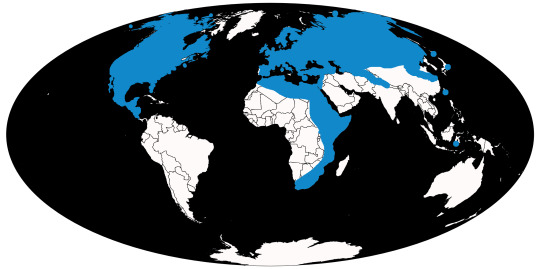
Physical Description: Mammoths were (mostly) large, elephanty creatures - with big bodies, long limbs, trunks, small tails, and tusks coming out of their mouths in both sexes. Most were about as large as Asian elephants, though some may have exceeded 12 tonnes. Still, there were dwarf species as well, which were quite small - some not even breaking 1000 kilograms. They grew their first tusks at the age of six months, which were then replaced at eighteen months by the permanent set. These would then grow at about 2.5 to 15.2 centimeters per year. Their teeth were distinctive - with rows of ridges that looked almost like the body of an arthropod (rather than the more flat surface seen in contemporary mastodons).

By FunkMonk, in the Public Domain
The mammoths had small ears, primarily due to the need to conserve body heat in most cases, unlike modern elephants which have larger ears with which to let off excess body heat. They had wide feet, splayed apart to help hold up their bodies. The males usually would grow larger than the females, based on the shape of the pelvis in fossils and frozen remains of these mammals. And, though a few species are very hairy - leading to the famed Woolly Mammoth - not all of them were, and many species of this genus were naked, with grey or more beige colored skin, as they lived in drier and warmer environments and needed to let off heat and sweat. Those that were hairy had thick layers of fur covering their entire bodies, even shorter tails to reduce frostbite, and thick layers of fat for keeping warm. A few species - notably, the Woolly Mammoth - had very brown, fluffy fur. Finally Mammoths, like modern elephants, were extremely intelligent animals, and had the brain and head size to match.

Woolly Mammoth by Mauricio Antón, CC BY 2.5
Diet: Mammoth diet varied from species to species and location to location of mammoths, though they were, overall, herbivores. Some mainly grazed on things like cacti leaves, trees, and shrubs; others, herbs, grasses, and shrubs; still more, forbs, rather than grass. Sometimes, babies that were no longer drinking milk would eat the poop of adults, like modern elephants, as they could not chew properly on plant material yet. This would also lead to feeding on fungi associated with poop, in addition to the plant material present.
Behavior: Mammoths were, in general, herding animals, much like modern elephants - in fact, it is theorized that they probably had social structures very similar to their living relatives. They had females living in herds, headed by a matriarch, that was the source of wisdom for the whole heard; meanwhile, the males would live alone or form loose groups of convenience when the situation arose. These herds would, oftentimes, migrate from region to region based on weather patterns and seasonal change. They could form herds of thousands of individuals of a variety of ages, with the adorable image of juveniles and young running to keep up with the strides of the much larger adults.
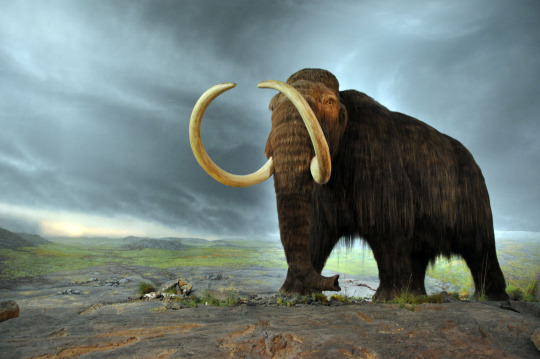
Woolly Mammoth by Flying Puffin, CC BY-SA 2.0
Mammoths, like modern elephants, mainly interacted with their environments with their trunks, which were essentially fifth limbs for these animals. They grabbed objects in their environments and talked to each other through the movement of their trunks. The trunks were also used for grabbing food in a lot of situations, pulling up coarse tundra grass and other food items and brought to the mouth, where it would then be chewed with the trough, specialized teeth. They used their tusks for defense from predators, though this wasn’t very helpful for the juveniles, who did not have extensive tusks. The mammoths also fought each other with their tusks, especially males, who would interlock the tusks and even break them while fighting for mates. They could also use the tusks to strip off bark and gather up food, even by digging in the dirt for food.
Ecosystem: Mammoths lived in a wide variety of habitats overall, though of course these differed from species to species. They lived across savanna and desert, steppe and tundra, grassland and scrubland, and even in sparse forest and higher elevations. As for predators, Mammoths were heavily at risk from predators such as lions, sabre-toothed cats, various types of wolves and other dogs, and of course, humans - which are probably the reason Mammoths are extinct today.

Cave Art from PalaeoAmerica, in the Public Domain, depicting two Columbian Mammoths (with a bison drawn over the right one)

Kapova Cave, in the Public Domain
Other: How did Mammoths go extinct? Apart from earlier species, the answer seems to be a combination of climate change and human activity. Multiple species - especially the Columbian and Woolly Mammoths - are known to have been hunted by humans, and cave drawings depict this activity for both of these species. This combination had a terrible effect on all species of mammoths - rising sea levels, with wildfires, and human hunting lead to the extinction of the Pygmy Mammoth, despite not being as large and specialized as those more iconic, giant species of mammoths elsewhere. Habitat shrinkage did not help with Mammoth populations; but human activity definitely contributed, as many populations of mammoth were heavily impacted by human activity. Prior to this, there was extensive genomic meltdown, as DNA diversity went into heavy decline for the past few thousand years. Isolated populations of mammoths - such as those on islands - showed the most extreme decline as the climate changed and humans became more common. The final death knell came from population fragmentation - with mammoths no longer having overlapping ranges, isolated populations were more susceptible to these rapid changes, and each subsequently went extinct due to climate change and human activity (with different causes being more or less important depending on the population in question).

Steppe Mammoth by Titus 322, in the Public Domain
Species Differences: There are 10 species of mammoth, each very distinct from the others, and each occupying unique environments and locations. Some are older than the others, as well.
The oldest species, M. subplanifrons, or the South African Mammoth, appeared about 5 million years ago - at the very beginning of the Pliocene. It spread from South Africa to the East African region, where it became most common in Ethiopia (funnily enough, the same time and location as human evolution, really). They were very similar to later mammoths, having spirally twisting tusks and large size - weighing up to 9 tonnes. They went extinct within the Early Pliocene and, given that they lived in Africa, were probably not very hairy as far as mammoths go; living mainly on savannas and other habitats that we see modern African Elephants on today.

African Mammoth by Apokryltaros, CC BY 2.5
The second oldest species, M. africanavus, the African Mammoths, lived from the Late Pliocene (about 3 million years ago) through the earliest part of the Pleistocene, about 1.65 million years ago. These two early species in Africa point to an African origin for the Mammoths. It has been found in Chad, Libya, Morocco, and Tunisia - showing the northern migration of Mammoths in their early evolution. They had very widely diverging tusks, much more so than other mammoths.
The next in the group, M. rumanus, the Romanian Mammoth, is one of our earliest examples of a Mammoth that spread to Europe - having been found in the late Pliocene of the UK and Romania. Being a very short lived and poorly known species, it is difficult to know much about it, though it does point to Mammoths migrating out of Africa through the Levant region, up to Eurasia from there. It’s possible that the Romanian Mammoth helps to show more about the dispersal of this genus through Eurasia as the Ice Age began in the Pleistocene.
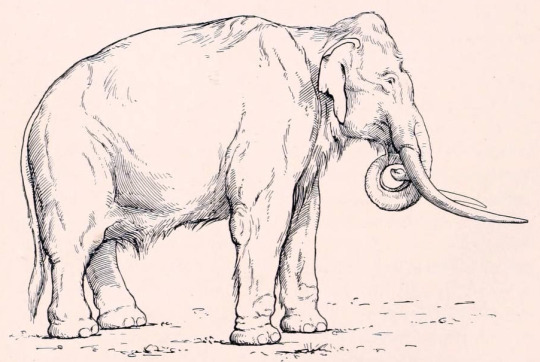
Southern Mammoth by Erwin S. Christman, in the Public DOmain
The Southern Mammoth, M. meridionalis, lived from the end of the Pliocene through the beginnings of the Pleistocene, and is known from Europe through Central Asia. It is known from many remains, which pinpoint that it may have been very closely related to the African Mammoth, though currently it is hypothesized that the South African Mammoth was the ancestor of all other forms. The Southern Mammoth grew to be about 4 meters tall and weighed 10 tonnes, making it one of the largest of the group. It had very robust, twisted tusks like other mammoths. It lived, generally, during a more mild time of the Ice Age, feeding mainly on deciduous trees and living in grassy, open habitats with small groves here and there. It was a browser, feeding mainly on higher level foliage.
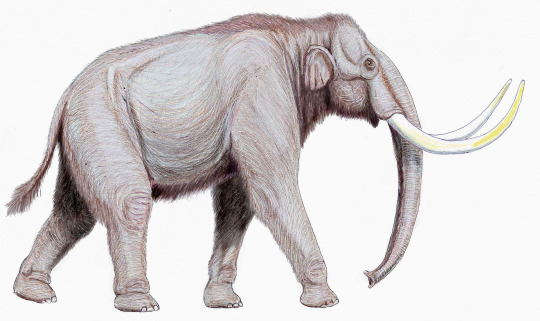
Steppe Mammoth by Dmitry Bogdanov, CC BY 3.0
All other Mammoths lived from the Pleistocene on, with some making it into the Holocene (and subsequently going extinct during the Pleistocene-Holocene Megafaunal Extinctions). The Steppe Mammoth is the next in our temporal sequence, M. trogontherii, known from Siberia in the middle of the Pleistocene - the first stage in the evolution of steppe and tundra mammoths during the glacial periods of the time. It probably had fur on most of its body - shorter than that of the Woolly Mammoth, but not by much. It had a short skull and small jaw compared to other mammoths, and the males had tusks with tips that could grow extra long and curved. They grew up to 4 meters tall and around 10 tonnes in weight. It is known mainly from fossilized teeth, with skeletons being rare, though some complete skeletons have been excavated in northern parts of the UK and siberia. It probably ate mainly shrub plants and tundra forbs.

Columbian Mammoth by Dmitry Bogdanov, CC BY-SA 4.0
The next species of Mammoth to evolve was the famed Columbian Mammoth, of the mid Pleistocene through Early Holocene of North America. Though it’s range was next to that of the Woolly Mammoth, they clearly divided North America between the two, with Woolly taking the northern half of the continent, and the Columbian mammoth taking the southern half. The Columbian Mammoth is known from a lot of fossils, across a variety of localities, and show the initial spread into North America by mammoths in an earlier in-between period of the Ice Age than the expansion of Woolly Mammoths later. It evolved from the Steppe Mammoth, which migrated across the Bering Strait into North America, down corridors available between glaciers through to the bulk of the area that would be the continental United States. The Columbian Mammoth grew to 4 meters in height and 10 tonnes in weight, making it larger than the Woolly Mammoth and the African Elephant. It also had fairly primitive teeth compared to other mammoths. It had tusks directed farther apart than those of other mammoths, and it had a longer tail. Since it lived in warmer habitats, it lacked a lot of the adaptations for the cold, and probably didn’t have much in the way of hair for keeping warm. Its tusks were excessively long, especially compared to modern elephants.
Many Columbian Mammoths are found in Elephant Graveyard fossil deposits, indicating areas where the bones of individuals would accumulate due to the movement of water. Additionally, many fossil remains are found in tar pit accumulations, in addition to sinkholes and other natural traps. Most fossils found in these sites are actually males, which were more likely to put themselves in danger than the females - lured to these holes by warm water and vegetation at the edges. These elephants would have needed to spend most of their day foraging, using their trunks to pull up grass, flowers, and other types of food. It’s possible that these mammoths could have reached even 80 years in age, growing for most of their lives.
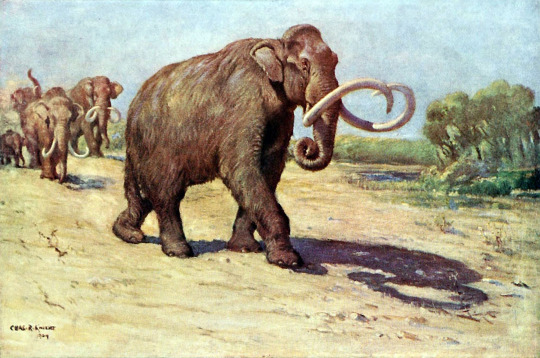
Columbian Mammoth by Charles R. Knight, in the Public Domain
The Cretan Dwarf Mammoth, M. creticus, is one of three diminished species of Mammoths, known from about 700,000 years ago on the island of Crete in the Mediterranean. These mammoths were very small, reaching only 1 meter tall and weighing only 310 kilograms - making it the smallest of the mammoths. It is possible that this animal wasn’t a mammoth at all, but another type of proboscidean; studies are still out on that one. Skulls of this animal may have formed the basis for the Grecian myth of the Cyclops!
The Sardinian Pygmy Mammoth, M. lamarmorai, was another species of small mammoth which evolved about 450,000 years ago, and is known only from the island of Sardinia. It grew about 1.4 meters tall and weighed up to 550 kilograms. It is known from many fossils, but no complete skeletons, mainly along the west coast. It is actually very uncertain what sort of mammoth this species originated from; it seems possible that the Steppe Mammoth colonized Sardinia, and then experienced Island Dwarfism as it was isolated on the island during an in-between period.
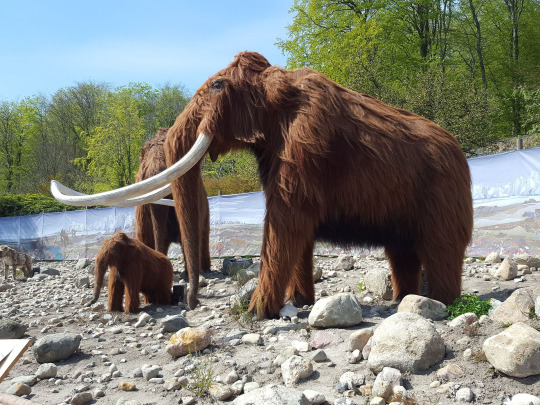
Woolly Mammoth by Honymand, CC BY-SA 4.0
The second to last species of Mammoth to evolve is, indeed, the best known of them all - M. primigenius, the Woolly Mammoth. Woolly Mammoths lived around the Arctic circle, in northern Eurasia and North America. Evolving from the Steppe Mammoth sometime between 400,000 and 150,000 years ago, it lived all the way up until the recent past, about 4,000 years ago - leading to the common fun fact that the Pyramids were built while Mammoths were still alive! Given it’s late position in the fossil record and extreme numbers during the last ice age, we have so many fossils and frozen remains of this animal that we know much of its life history (and the Woolly Mammoth remains one of the most controversial examples of something we might actually bring back through de-extinction). Because of this abundance of remains, we know a lot about its life appearance and life history - in fact, it’s the prehistoric animal with the best known appearance.
Woolly Mammoths were - as the name suggests - woolly, covered in layers of fur all over their bodies which was brown in color, as well as very thick layers of fat, very small ears and short tails, and flaps of skin covering orifices to keep them warm. The mammoths had oil glands in their skin, which secreted into their hair and helped the hair in repelling water, and gave the hair a glossy sheen. There was long, coarse guard hair on the outer layer, covering curly under-wool underneath. Interestingly enough, the Woolly Mammoth also had some weird physical characteristics not related to the warmth, such as a very high, domed head, and a sloping back with a shoulder hump. These were more present in adults, and not visible in juveniles. Their tusks were asymmetrical and extremely varied, and weirdly enough, most of the length of the tusks was inside the mouth. They had four molars at a time, used for chewing very tough vegetation.
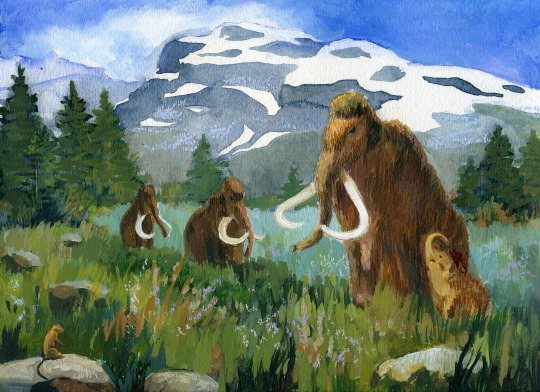
Woolly Mammoths by Kira Sokolvskaia, CC BY-SA 3.0
The Woolly Mammoth was the most specialized elephant to ever live, with extreme amounts of fat stored for warmth and when food was unavailable; their molars grew more quickly than in modern elephants; and their fur was so thick it was as though they wore mittens all over their bodies. They had differences in circadian rhythm clocks from living elephants in order to deal with extreme variation in daylight levels, and its proteins were less sensitive to heat. They had about 1.4 million differences in DNA compared to their closest living relatives, the Asian Elephants. They fed mainly on herbs, small flowering plants, shrubs, and mosses, and even fungus and poop from each other - not just the young, but the adults would do this too in times of food scarcity. They probably could reach up to 60 years of age, and they grew past adulthood - like living elephants.
The males also would go into musth - a period of extreme aggressiveness - during the breeding season, like living elephants today. They produced oil with glands that moved a smell associated with musth all over their fur, signaling to female mammoths they were ready to go, and to male mammoths to leave them alone. The breeding season was typically in the summer through the beginning of fall. The mammoths gave birth during the spring and summer, after a gestation period of nearly two years. While many reached older age and adulthood, bone disease was a very common cause of death for these mammals, as well as parasitic animals and infections after poorly healed injuries. Still, many were murdered by humans, and mammoth bits are used heavily in human society - for food, warmth, and art, with ivory from mammoths used in sculptures by early humans.
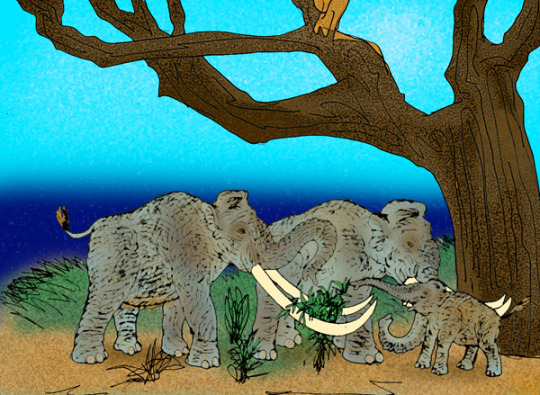
Pygmy Mammoth by Apokryltaros, CC BY 2.5
Finally, Pygmy Mammoths - M. exilis - were the last species to evolve, evolving approximately 60,000 years ago; still, it didn’t live as long as the Woolly Mammoth, dying out about 11,000 years ago, right at the beginning of the Holocene. The third case of insular dwarfism in the Mammoths, it grew to about 1.72 meters tall at the shoulders and 760 kilograms in weight. It evolved from the giant Columbian Mammoth, as well, making this all the more impressive. It is known from the Channel Islands along California, where Columbian Mammoths presumably reached via land bridges during some glacial period of the Ice Age. Possibly, they also swam there in search of food and escaping the large predators of the mainland such as Smilodon and the American Lion. It thrived across a variety of ecosystems, including plateaus, dunes, grasslands, forests, and even steppe-tundras.
~ By Meig Dickson
Sources under the Cut
https://en.wikipedia.org/wiki/Mammoth
https://en.wikipedia.org/wiki/African_mammoth
https://en.wikipedia.org/wiki/Columbian_mammoth
https://en.wikipedia.org/wiki/Mammuthus_creticus
https://en.wikipedia.org/wiki/Pygmy_mammoth
https://en.wikipedia.org/wiki/Mammuthus_lamarmorai
https://en.wikipedia.org/wiki/Mammuthus_meridionalis
https://en.wikipedia.org/wiki/Woolly_mammoth
https://en.wikipedia.org/wiki/Mammuthus_rumanus
https://en.wikipedia.org/wiki/Mammuthus_subplanifrons
https://en.wikipedia.org/wiki/Steppe_mammoth
#Mammuthus#Mammoth#Woolly Mammoth#Not a Dinosaur#Mammal#April Fool's#Prehistoric Life#Prehisotry#Paleontology#North America#Eurasia#Africa#Neogene#Quaternary#Herbivore#Ice Age#prehistory#biology#science#nature#factfile
862 notes
·
View notes
Photo



Island Weirdness #53 — Tiny Elephants On Parade
Part 5: Western Mediterranean
During the Pleistocene elephants colonized many of the islands in the Mediterranean Sea, with each island independently developing its own unique dwarfed form.
Mammuthus lamarmorai lived on the island of Sardinia during the middle and late Pleistocene, between about 450,000 and 40,000 years ago. Standing around 1.4m tall at the shoulder (4'7"), it was a dwarf form roughly one-third the size of its ancestor, the huge Eurasian steppe mammoth.
Its remains are known only from the west and south of the island. Strangely it appears to be have been absent from the nearby island of Corsica, despite the two being joined as a single landmass a few times during lower sea level periods in the Pleistocene.
It's not clear why this mini-mammoth disappeared. The date of the earliest human settlement of Sardinia is controversial (ranging from 250,000 to 20,000 years ago), so Mammuthus lamarmorai might never have actually encountered them. Instead it may have struggled to cope with climate changes during the last glacial period towards the end of the Pleistocene, which rapidly turned Sardinia colder and drier.

Over on Sicily and Malta (which were also occasionally a single island when sea levels were lower), there were several different species of miniature elephant during the mid-to-late Pleistocene, each with a different body size and occupying its own ecological niche. They were all descendants of the massive straight-tusked elephant (Palaeoloxodon antiquus) but each resulted from independent colonization waves swimming over to the island(s).
Palaeoloxodon falconeri lived during the mid-Pleistocene, about 550,000 years ago, and was both the smallest of the Mediterranean dwarfs and possibly the smallest elephant to ever exist. Just 0.8-1m tall (2'7"-3'3"), it had adult body proportions resembling the juveniles of its ancestors, limbs adapted for running and clambering over rough terrain, and a proportionally enormous brain relative to its body size.
Around 200,000 years ago a sea level drop allowed new colonization from the Italian mainland. If Palaeoloxodon falconeri was still around at that time it likely didn't survive long with new competition from large herbivores like bison and deer, and being preyed on by newly-arriving large carnivores like wolves, lions, and hyenas.
Another small elephant soon evolved to take its place, although due to the presence of predators it was never able to get nearly so tiny.
Palaeoloxodon mnaidriensis was in fact one of the largest dwarf elephants in the Mediterranean, standing about 1.8-2m tall (5'11"-6'6"), but despite its larger size its limbs still show signs of adaptation for more fast and agile movement. Its tusks also show a lot of variation in shape, with some much more curved and twisted than others.
This elephant had disappeared by about 13,000 years ago, probably due to the climate significantly warming towards the end of the last ice age. Much like Sardinia, the earliest arrival of humans on Sicily and Malta is controversial, and it's unclear whether they ever encountered Palaeoloxodon mnaidriensis — the earliest definite date for Sicily is about 16,000 years ago, so a human-induced extinction can't be ruled out entirely.
The subfossil remains of the Siculo-Maltese elephants may have also ended up inspiring legends of the cyclops, as their skulls would have resembled large human ones with the nasal cavity forming a single big "eye socket".

#science illustration#island weirdness 2019#paleontology#paleoart#palaeoblr#mammuthus#mammoth#palaeoloxodon#elephantidae#elephant#elephantiformes#proboscidea#mammal#art#insular dwarfism#sardinia#sicily#malta#mediterranean#holocene extinction#maybe#island weirdness 2: endemic boogaloo#tiny elephants on parade
245 notes
·
View notes
Photo



Island Weirdness #61 — Tiny Elephants On Parade
Part 6: Eastern Mediterranean
Alongside the weird deer, otters, and owls, the island of Crete also had dwarf elephants — and much like Sardinia to the west the Cretan elephants were actually descendants of mammoths rather than the Palaeoloxodon seen in the rest of the Mediterranean.
Mammuthus creticus was originally thought to also be a palaeoloxodontine, but more recent studies of its anatomy and ancient DNA have confirmed it was indeed another tiny mammoth. It was probably descended from either the Southern mammoth or Mammuthus rumanus, which would have arrived on Crete during the late Pliocene or early Pleistocene between about 3.5 and 1 million years ago.
Isolated on Crete, with no predators and living at a time when the island was much smaller, it quickly dwarfed and became the tiniest known mammoth to ever exist, standing just 1.1m tall at the shoulder (3'7"). Not much is known about its ecology, but its teeth suggest it was a browser feeding on leaves and shrubs, possibly filling a similar niche to the mid-sized deer that came later.
This mini-mammoth seems to have gone extinct by the mid-Pleistocene, about 1 million years ago, around the time when rising sea levels during an interglacial phase may have submerged so much of the smaller proto-Crete that its population could no longer be supported.
Later in the mid-to-late Pleistocene, after the sea level dropped again and tectonic uplift brought Crete close to its modern dimensions, the small mammoths were replaced by both newly-arriving deer and Palaeoloxodon elephants, which evolved into the much more moderately dwarfed forms of Palaeoloxodon creutzburgi and Palaeoloxodon chaniensis.

The the north and east of Crete the Cyclades and Dodecanese islands had endemic dwarf elephants on at least eight islands, with the best known being the species that lived on Tilos.
Palaeoloxodon tiliensis stood about 1.8m tall (5'11"), on the larger side for a dwarf Mediterranean elephant but still one of the smallest palaeoloxodontines in the Aegean region. Several thousand specimens have been found, and radiocarbon dating shows it was a fairly recent evolutionary development, appearing just 45,000 years ago in the late Pleistocene.
This dwarf elephant was also the very latest surviving of its entire kind, living well into the Holocene until at least 4000 BCE. This is several thousand years after humans first arrived on Tilos, suggesting it was a rare case of an island elephant that managed to endure the effects of a human presence for quite some time.
In fact there's some speculation that Palaeoloxodon tiliensis (or a similar unknown species) may have survived for even longer than that, since one Ancient Egyptian tomb from around 1480-1400 BCE contains a painting depicting traders with exotic animals, including what appears to be a small hairy elephant with slender limbs and thin upward-curving tusks. We may never know for certain if this was actually a late-surviving dwarf, a mutant modern elephant, or just artistic license with scaling, but the possibility is still intriguing.
Over on isolated Cyprus further to the east, the only native large mammals were the miniature hippos and an equally miniature elephant.
Palaeoloxodon cypriotes was smaller than the Aegean palaeoloxodontines, about 1.4m tall (4'7"), and much like its cousin on Tilos seems to have evolved very recently towards the end of the Pleistocene, sometime around 20,000 years ago.
It wasn't the first dwarf elephant on Cyprus — there was a larger, earlier species known as Palaeoloxodon xylophagou at least 200,000 years ago — but it's not clear whether these two species represent a single evolutionary line or two entirely different colonizations of the island.
Similarly to the hippos it lived alongside, Palaeoloxodon cypriotes disappeared shortly after humans arrived on Cyprus, between 12,000 and 10,000 years ago. Collections of its bones have been found in a rock shelter with evidence of having been burnt, suggesting that it was being actively hunted and cooked.

And that's all for the Island Weirdness series! Even over two months there are still plenty of species I didn't have time to feature, so this definitely won't be the last we see of strange endemic species.
Thank you for following along — with a shoutout to my Patreon supporters! — and regular weekly art posts will resume here next Monday.
#science illustration#island weirdness 2019#paleontology#paleoart#palaeoblr#mammuthus#pygmy mammoth#mammoth#palaeoloxodon#elephantidae#elephant#elephantiformes#proboscidea#mammal#art#insular dwarfism#crete#tilos#dodecanese#aegean#cyprus#mediterranean#holocene extinction#island weirdness 2: endemic boogaloo#tiny elephants on parade#long post
175 notes
·
View notes
Photo


Island Weirdness #44 — Tiny Elephants On Parade
Part 4: Mammoth-Mimics & Mini-Mammoths
In the cool-temperate climate of Pleistocene Japan one type of small elephant seems to have convergently become somewhat of a mammoth-mimic, with twisting tusks and possibly even a thick coat of hair.
Palaeoloxodon naumanni lived during the late Pleistocene, between about 500,000 and 16,000 years ago. At about 2-2.5m tall at the shoulder (6'6"-8'2") it was still fairly large, similar in size to the smallest living elephant species — but it was a dwarf in comparison to its immediate ancestors, the absolutely enormous Asian straight-tusked elephant (Palaeoloxodon namadicus).
Actual woolly mammoths (Mammuthus primigenius) were also present in Japan, but the two similar-looking elephants inhabited different environments — Palaeoloxodon naumanni preferred the southern forests, while the true mammoths roamed the colder north.
Humans arrived in Japan around 40,000-30,000 years ago, so Palaeoloxodon naumanni actually coexisted with them for quite some time. Although it was hunted, it seems to have mainly been climate change towards the end of the last glacial maximum that led to its extinction.

Over on the other side of the Pacific Ocean, at least 60,000 years ago, some huge Columbian mammoths (Mammuthus columbi) swam the 6.5km (4 miles) distance to the ancient island of Santa Rosae — a landmass that today is mostly submerged, with its remaining peaks forming the modern California Channel Islands.
With a lack of large predators and then steadily rising sea levels reducing the available habitat on their new home, the mammoths shrank into a dwarfed species known as the Channel Islands pygmy mammoth (Mammuthus exilis). Standing around 1.75-2m at the shoulder (5'9"-6'6"), they were less than half the size of their ancestors and had only about 10% of the body mass.
The pygmy mammoths survived until about 13,000 years ago, around the same time that early Paleoindians arrived. While they may also have been hunted by humans, the warming post-glacial climate is currently thought to be the main factor in their extinction, changing the types of vegetation on their still-shrinking islands and reducing fresh water sources.

(And if you prefer your pygmy mammoths less speculatively hairy, there's always the version I did for PBS Eons earlier this year.)
#science illustration#island weirdness 2019#paleontology#paleoart#palaeoblr#palaeoloxodon#naumann's elephant#mammuthus#pygmy mammoth#elephantidae#elephantiformes#elephant#proboscidea#mammal#art#insular dwarfism#japan#channel islands#california#island weirdness 2: endemic boogaloo#tiny elephants on parade
196 notes
·
View notes
Photo




It's finally time for part 2 of the Island Weirdness series!
(If you haven't seen the previous installments, I suggest starting back at the beginning here.)
We left off last time with the dwarf stegodontids of Flores, but other Indonesian islands also had their own populations of unusually small elephant-relatives — so here's a few more to start off this month.
———
Island Weirdness #32 — Tiny Elephants On Parade
Part 3: More Indonesia
Sinomastodon bumiajuensis lived on the island of Java during the early Pleistocene, about 2-1.5 million years ago. It stood around 2m tall at the shoulder (6'6"), less than half the size of most other Sinomastodon species from mainland Asia. Although it looked convergently similar to modern elephants it was actually a member of the gomphotheres, much more closely related to the weird "shovel-tuskers" than to any living species.
Stegodon semedoensis, also from the early Pleistocene of Java about 1.5 million years ago, is only known from a few isolated molar teeth — but the size of those teeth suggest it was one of the smallest known pygmy stegodontids. It was probably no more than 1.2m at the shoulder (3'11"), comparable in size to its close relative Stegodon sondaari over on Flores.

Meanwhile on Sulawesi, Elephas celebensis (sometimes called Stegoloxodon celebensis) was an actual true elephant closely related to the modern Asian elephant. Living during the late Pliocene and early Pleistocene, between about 2.5 million and 800,000 years ago, it was only 1.5m tall (5') and had a second set of tusks in its lower jaw, a "primitive" feature retained from the gomphothere-like ancestors of modern elephants.
At the same time Sulawesi also had yet another small stegodontid, Stegodon sompoensis, also around 1.5m tall.
Both of these dwarfs lived alongside a larger Stegodon species, as well as giant tortoises and large-tusked pigs.

The cooling climate of the Pleistocene and dropping sea levels eventually connected the islands of western Indonesia to the Sundaland landmass of mainland Asia. Influxes of new predators and competitors — and early humans — probably drove these endemic small elephants to extinction.
#science illustration#island weirdness 2019#paleontology#paleoart#palaeoblr#sinomastodon#gomphothere#stegodon#stegodontidae#elephas#stegoloxodon#elephantidae#elephant#elephantiformes#proboscidea#mammal#art#insular dwarfism#java#sulawesi#indonesia#island weirdness 2: endemic boogaloo#tiny elephants on parade
172 notes
·
View notes
Photo


Island Weirdness #31 -- Tiny Elephants On Parade
Part 2: Flores
Much like Japan, ancient Flores had a succession of dwarf stegodontids -- close relatives of modern elephants that were capable of island-hopping through Indonesia by swimming.
Stegodon sondaari lived on Flores during the Early Pleistocene, about 900,000 years ago, and was the size of a small water buffalo at just 1.2m (3′11″) tall at the shoulder. It was probably descended from the larger Stegodon trigonocephalus, known from Java, and it had proportionally short legs which may have been an adaptation to clambering over rough terrain and steep inclines.
Around 850,000 years ago Stegodon sondaari disappeared from Flores, probably due to a large volcanic eruption, but a new wave of stegodontids quickly recolonized the island. The mid-sized Stegodon florensis probably originated from either Java to the west or Sulawesi to the north, and eventually evolved into a new dwarfed subspecies.
Stegodon florensis insularis wasn’t quite as small as its predecessor, standing around 1.8m tall (5′10″). It probably didn’t shrink quite so much due to the existing presence of various predators on Flores, since it was likely the main prey of large Komodo dragons, it was hunted by Homo floresiensis, and it may also have been occasionally targeted by giant storks.
It seems to have disappeared around the same time as several other unique endemic species, between 50,000 and 20,000 years ago, due to either climate change, another volcanic eruption, or the arrival of modern humans -- or perhaps a combination of all of those factors.

And that’s all for this month... but Island Weirdness will be back later for part 2, with more giants, more dwarfs, and so many elephants.
#island weirdness 2019#paleontology#paleoart#palaeoblr#stegodon#stegodontidae#elephantoidea#elephantiformes#proboscidea#mammal#art#insular dwarfism#flores#indonesia#holocene extinction#island weirdness part 1#tiny elephants on parade
157 notes
·
View notes
Photo


Island Weirdness #13 -- Tiny Elephants On Parade
Part 1: Japan
Part of the “island rule” is that large animals often become smaller -- and no group seems to exemplify this more than the elephants.
Although they’re the largest living land animals today, and in the past included some of the largest known land mammals ever, ancient elephants also frequently ended up on islands thanks to their ability to swim long distances. They produced many different dwarfed forms around much of the world, and a few of them will be featured intermittently throughout both months of this theme.
The earliest known examples were the stegodontids of Japan in the early Miocene. These animals weren’t quite true elephants, instead being close evolutionary cousins to them, and had two small additional tusks in their lower jaws similar to the related gomphotheres.
Stegolophodon pseudolatidens first arrived in Japan about 18 million years ago, and within just 2 million years they’d developed into insular dwarfs that were probably around 2m tall at the shoulder (6′6″) -- still reasonably large, but only about 60% the size of their mainland relatives.
Much later in the Early Pleistocene another small almost-elephant appeared in Japan. Living between about 2 million years ago and 700,000 years ago, Stegodon aurorae was about the same size as the then-extinct Stegolophodon but probably wasn’t descended from them. Instead it was probably the result of a separate arrival and dwarfing of a larger Stegodon species from mainland Asia.

#island weirdness 2019#science illustration#paleontology#paleoart#palaeoblr#stegolophodon#stegodon#stegodontidae#elephantoidea#elephantiformes#proboscidea#mammal#art#insular dwarfism#tiny elephants on parade#island weirdness part 1
162 notes
·
View notes
Photo

African bush elephant (Loxodonta africana)
Photo by Johan Swanepoel
#african bush elephant#african elephant#elephant#loxodonta africana#loxodonta#elephantinae#elephantidae#elephantoidea#elephantimorpha#elephantiformes#proboscidea#tethytheria#paenungulata#afrotheria#atlantogenata#eutheria#mammalia#tetrapoda#vertebrata#chordata#juvenile
2 notes
·
View notes
Photo

African bush elephant (Loxodonta africana)
Photo by Mark Bridger
#african bush elephant#african elephant#elephant#loxodonta africana#loxodonta#elephantinae#elephantidae#elephantoidea#elephantimorpha#elephantiformes#proboscidea#tethytheria#paenungulata#afrotheria#atlantogenata#eutheria#mammalia#tetrapoda#vertebrata#chordata#fave
19 notes
·
View notes